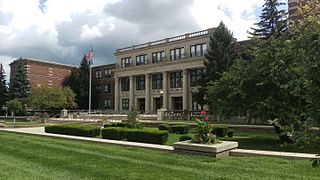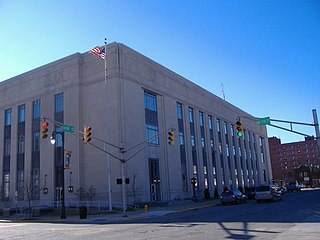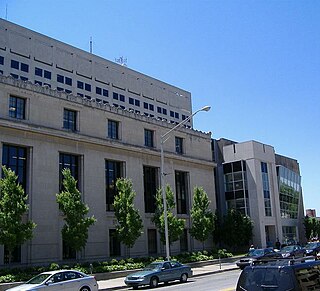John Lloyd Wright was an American architect and toy inventor. Born in Oak Park, Illinois, Wright was the second-oldest son of famed architect Frank Lloyd Wright. John Lloyd Wright became estranged from his father in 1909 and subsequently left his home to join his brother on the West Coast. After unsuccessfully working a series of jobs, he decided to take up the profession of his father in 1912. Shortly afterward, he was able to reconnect with his father, who took John under his wing. Differences in opinion regarding the Imperial Hotel, Tokyo caused the pair to again become disunited.
Bernard Vonnegut was an American atmospheric scientist credited with discovering that silver iodide could be used effectively in cloud seeding to produce snow and rain. He was the older brother of American novelist Kurt Vonnegut.

Shortridge High School is a public high school located in Indianapolis, Indiana, United States. Originally known as Indianapolis High School, it opened in 1864 and is the oldest public high school in the state of Indiana. Shortridge is the home of the International Baccalaureate and arts and humanities programs of the Indianapolis Public Schools district.(IPS). Out of 406 public high schools in Indiana, Shortridge was ranked as the 23rd best in 2018 by US News & World Report.

The Indianapolis Public Library is the public library system serving the citizens of Marion County, Indiana, United States and its largest city, Indianapolis. The library was founded in 1873 and has grown to include a Central Library building, located adjacent to the Indiana World War Memorial Plaza, and 23 branch libraries spread throughout the county. The library attracts over four million visitors each year and circulates nearly 16 million items.

The Athenæum, originally named Das Deutsche Haus, is the most ornate and best-preserved building affiliated with the German American community of Indianapolis. Once used as a German American Turnverein and clubhouse, it currently houses many groups, organizations, and businesses. The Athenæum is located across Massachusetts Avenue from the Old National Centre. It was placed on the National Register of Historic Places on February 21, 1973. On October 31, 2016, it was named the 41st National Historic Landmark in Indiana.

Bohlen, Meyer, Gibson and Associates, or BMG, is an architectural firm based in Indianapolis, Indiana. It was founded in Indianapolis on April 10, 1853, as D. A. Bohlen, Architect by Diedrich A. Bohlen, German immigrant. In 1884, after Diedrich's son, Oscar D. Bohlen, joined the firm it was renamed D. A. Bohlen and Son. Four successive generations of Bohlen architects have worked at the firm: Diedrich A. Bohlen, Oscar D. Bohlen, August C. Bohlen, and Robert L. Bohlen. The firm specialized in institutional projects, especially civic, religious, and educational buildings. In 1971 Melvin B. G. Meyer acquired majority interest in the firm, which adopted its name in reference to its founder and its two principal architects, Meyer and John M. Gibson. The architectural firm is among the oldest still operating in the United States. More than twenty of its projects are listed on the National Register of Historic Places.

Vonnegut & Bohn was an architectural firm in Indianapolis, Indiana in the United States.
Vonnegut, Wright & Yeager was an architectural firm active in mid-twentieth-century Indiana. The firm was organized in 1946 as a partnership between the surviving partners of three Indiana firms: Kurt Vonnegut Sr. (1884–1957) of Vonnegut, Bohn & Mueller Architects; George Caleb Wright of Pierre & Wright; and Ralph Oscar Yeager of Miller & Yeager. It was located at 1126 Hume Mansur Building, Indianapolis, Indiana and 402 Opera House Building, Terre Haute, Indiana.
Kurt Vonnegut Sr. was an American architect and architectural lecturer active in early- to mid-twentieth-century Indianapolis, Indiana. A member of the American Institute of Architects, he was partner in the firms of Vonnegut & Bohn, Vonnegut, Bohn & Mueller, and Vonnegut, Wright, and Yeager. He designed several churches, banks, and became the inhouse architect for Indiana Bell and Hooks Drug stores, practicing extensively in the Art Deco style. He was the father of chemist Bernard Vonnegut and author Kurt Vonnegut Jr.

Bernard Vonnegut I, WAA, FAIA, was an American lecturer and architect active in late-nineteenth and early-twentieth-century Indiana. He was a co-founder of the locally renowned Indianapolis architectural firm of Vonnegut and Bohn, and was active in a range of residential, religious, institutional, civic, and commercial commissions. He is the namesake and grandfather of scientist Bernard Vonnegut, father of the architect Kurt Vonnegut Sr., and grandfather of author Kurt Vonnegut.

Arthur Bohn, AIA, (1861–1948) was an American architect active from the 1880s to 1940s in Indiana. He was a co-founder of the Indianapolis architectural firm of Vonnegut and Bohn.
Ralph Oscar Yeager, AIA, was an American architect who worked in Indiana. He was a partner in the Terre Haute, Indiana architectural firm of Miller & Yeager and the Indianapolis, Indiana architectural firm of Vonnegut, Wright & Yeager.

Miller & Yeager was an architectural firm in Terre Haute, Indiana in the United States. It was founded in 1925 by Ewing Miller and Ralph Oscar Yeager, AIA,. It was one of the predecessor firms of Vonnegut, Wright & Yeager.
Bruce McCarty, FAIA was an American architect, founder and senior designer at McCarty Holsaple McCarty Architects of Knoxville, Tennessee. During a career that has spanned more than a half-century, he designed some of the city's iconic landmarks, and was the city's most dedicated champion of Modern architecture. Buildings designed or co-designed by McCarty include the Lawson McGhee Library, Knoxville City County Building, University of Tennessee Humanities Complex, Clarence Brown Theatre, and University of Tennessee Art and Architecture Building. McCarty was also the Master Architect for the 1982 World's Fair.

Woollen, Molzan and Partners (WMP) is a U.S.-based second-generation architecture, interior design, and planning firm that Evans Woollen III founded in Indianapolis, Indiana, in 1955. The firm was previously known as Evans Woollen and Associates and Woollen Associates. It remained in business for more than fifty-five years before closing its doors in 2011. Woollen began by designing mid-century modern residences, but the firm's design projects expanded to include a diverse portfolio of designs for libraries, worship facilities, museums, performing arts centers, private residences, public housing, and correctional facilities, among other projects.

The Kurt Vonnegut Museum and Library is dedicated to championing the literary, artistic, and cultural contributions of the late writer, artist and Indianapolis native Kurt Vonnegut, Jr.. It opened in January 2011 and is located in the Emelie Building, a structure on the National Register of Historical Places at 340 North Senate Avenue in Indianapolis, Indiana. The library serves as a cultural and educational resource facility, museum, art gallery and reading room. It supports language and visual arts education through programs and outreach activities with other local arts organizations to foster a strong arts network for both the local and national community.

The Schnull–Rauch House, sometimes referred to as the Victorian Manor and now also branded as The Manor at The Children's Museum of Indianapolis, is a National Register of Historic Places-designated Romanesque Revival historic home constructed in the early 20th century at 3050 North Meridian Street, in the Meridian-Kessler neighborhood north of downtown Indianapolis.
Edwin Arthur Gibson was an American architect active in Indianapolis, Indiana from 1946 to 2002. His career was one of many firsts. Gibson was the first registered African American architect in the State of Indiana, first African-American architect to be appointed Indiana's State Architect, and first African-American architect in Indiana to own his own firm. His long career included work in both the public and private sector. Gibson overcame many obstacles to become successful and was generous in offering advice and helping younger architects achieve similar success.
Evans Woollen III was an American architect who is credited for introducing the Modern and the Brutalist architecture styles to his hometown of Indianapolis, Indiana. Woollen, a fellow of the American Institute of Architects (FAIA) and a graduate of the Yale School of Architecture, was active in the field from the mid-1950s to the early 2000s. He established his own architecture firm in Indianapolis in 1955 that became known as Woollen, Molzan and Partners; it dissolved in 2011. As a pacesetter among architects in the Midwest, Woollen, dubbed the dean of Indiana architects, was noted for his use of bold materials and provocative, modern designs.

















